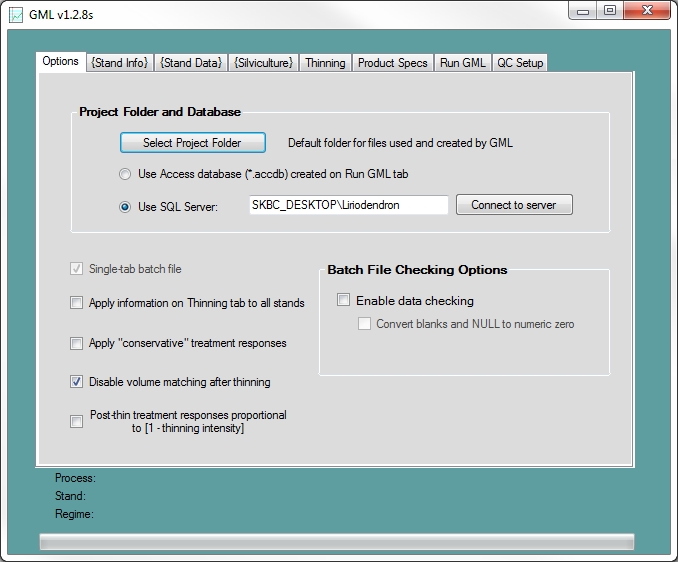The Options tab has settings for GML program execution and data checking. Thinning information can be entered with the user interface or with batch files.
In GML ver. 1.2.8, the batch file format is set to Single tab batch file, where all input data are on a single Excel worksheet named “OneTabInput”, and file types are set to Office 2007-2013 (*.xlsx and *.accdb). The four-tab version of the batch file (StandInfo, StandData, Silviculture, and Thinning tabs or worksheets) and Office 1997-2003 file types (*.xls and *.mdb) can be reactivated on request.

The project folder and database can specified by using the Options tab. The Project Folder is used to select a default folder for files that are used and created by GML. A new Access database or SQL Server can be selected for the project database. New Access databases can be created with the appropriate table structure. When the “Use SQL Server” button is selected, the full server name (computer_name\server_name) is either read from a file or else manually entered. The “Connect to server” button checks SQL Server for a “GML” database and its 11 tables before connecting. Once connected to SQL Server, data in all of the tables are deleted.
Checking the “Apply information on Thinning tab to all stands” allows a standard thinning specification to be applied to all stands in a batch file. When this box is unchecked, thinning specs. for each individual stand in a batch file are applied.
The default growth response for several of the loblolly pine silvicultural treatments are substantial. More conservative treatment responses can be applied by checking the “Apply conservative treatment responses” box.
The volume matching process uses interpolation to transition from observed volume to model-predicted volume. By default, volume matching is disabled after thinning. Unchecking the box will result in the volume matching process to continue after thinning.
The post-thinning response to silvicultural treatments that are applied before thinning is proportional to residual basal area or trees/acre when the “Post-thin treatment responses…” box is checked. When unchecked, the response to silvicultural treatments that are applied before thinning are deactivated at ages greater than thinning age.
A series of data consistency checks can be run against batch files at the beginning of the growth process. Errors are likely to cause GML to abnormally end, while warnings may cause illogical or invalid results. After running the data checks, an Excel workbook can be created to provide details of errors and warnings. Information includes the data tab, row number, name of variable with an issue, and a description of the issue.